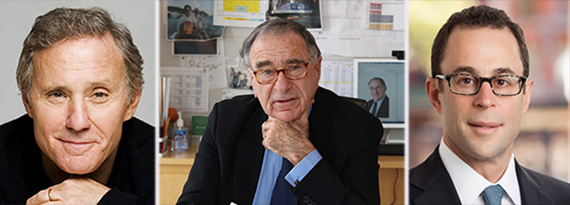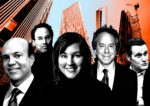Trending
Blau, Macklowe and Schrager talk developer’s role in shaping the future of NYC
Industry giants share their philosophies & responsibilities they owe to the city

UPDATED February 8, 2016, 10:36 a.m.: Just as construction was set to begin on the honeycomb-like sculpture planned for Hudson Yards, Related Companies’ CEO Jeff Blau noticed a problem: all the pieces were piled up in the wrong railyard. The copper-clad steel pieces were marooned on the Western Yards, and despite painstaking planning to transport the parts from Italy, no one accounted for one crucial part of the trip.
“Well, we figured out how to build it in Italy, ship it through the canals, across the ocean, into New York, onto the truck, across the bridge, down West Side Highway — we can’t Get It Across 11th Avenue,” Blau [TRDataCustom] recounted at a panel Friday night. The weight of the cargo, it turns out, requires a permit for heavier loads to go across 11th Avenue, so Related is waiting on those approvals before it can move the pieces over to the Eastern Yards.
The 16-story sculpture, designed by Thomas Heatherwick and dubbed “the Vessel,” will cost $180 million (a higher price tag than announced in September because it includes other associated costs, like landscaping). Blau envisions the piece as a “365-day a year Christmas tree” that will be a must-see for all New York City visitors, something of a Rockefeller Center on the Far West Side.
Blau discussed the project at a panel on Friday held by Hundred Stories and the 92nd Street Y as part of a real estate summit entitled “City of Tomorrow.” Blau shared the stage with two other giants in the development community, Harry Macklowe and Ian Schrager, to discuss how they and their peers are shaping the city’s skyline.
When the moderator asked how the developers think about their responsibility to the city beyond their individual buildings, Blau cited the Vessel — which will have some 2,500 steps that visitors can climb — and the six-acre public open space at the center of Hudson Yards as an example of how developers can contribute to the public good. Macklowe, the developer behind 432 Park Avenue and the driving force behind the Apple “Cube,” noted that it’s not just about open space. He said developers bring together “so many remarkable ideas and so many talented people” to shape the city. He waxed poetic about the role of developers a few times throughout the panel — each time to applause — and repeatedly referred to them as artists who, of course, hope that what they’re building is profitable, but who are driven by more than the bottomline.
“There’s this inherent prejudice that the developer is not even a wolf in sheep’s clothing, that he is worse than a wolf and almost a predator,” he said. “The development community, these days, is so enlightened that nobody, whether it’s an amateur or a very professional and profound company, is building without an amazing amount of knowledge, resources, intellect, purpose and objectives.”
Hotelier Ian Schrager, the co-founder of the legendary Studio 54 and developer of residential projects like 40 Bond Street and 50 Gramercy Park North, drew a similar conclusion. He told the audience his first concern is the standard of the product, rather than the potential profit. “I think the responsibility is to do something really great, really original and really innovative,” he said, adding that people today are lacking social interaction, which means collective community spaces — in the form of offices or hotels — are especially important.
“Our approach is: the money will come as a consequence of doing something great…If the product is great, you get a premium for it,” he said. He said he does not carefully consider markets or neighborhoods in planning his projects, as they are constantly shifting and subject to change.
Related, however, is precise in its sales targets. Blau said the company decided early to avoid focusing on ultra-luxury apartments, because that market relies heavily on overseas investors and sales are subject to numerous geopolitical risks.
“What we’ve tried to do is build to the top of the domestic buyers,” he said. “We study ‘what is the top two percent of earners in New York City, what does an investment banker on Wall Street make? And if you do the math, and he has to live in New York and pay expenses, how much could that person afford to pay for an apartment?”
Macklowe said that when Sandy Weill’s apartment at 15 Central Park West sold for $88 million in 2012, it was the “shot heard around the world” and emboldened Extell Development to aim for prices up to $7,000 per square foot.
But Blau interrupted, saying that when Macklowe was building luxury product, sky-high sales were a bonus, not a necessity. “When you did it, you didn’t need those prices,” he said. “The six buildings that came after you, they needed those numbers to make the numbers work. And that’s the scary thing.”
Clarification: An earlier version of this story said that 11th Avenue can’t handle the weight of the Vessel’s pieces, based on the description provided by Jeff Blau. Related later clarified that transporting the sculpture’s pieces simply requires another permit, given the heaviness of the load.




